The paradigm of diagnostic imaging is undergoing a profound transformation, propelled by the converging demands for accelerated, precise diagnoses and optimized operational workflows. Teleradiology has evolved from a supplementary after-hours service into a core strategic component for modern healthcare ecosystems, from major metropolitan medical centers to remote rural clinics. Selecting the right teleradiology partner is no longer a simple procurement decision; it is a critical strategic choice that profoundly impacts patient outcomes, data integrity, and institutional financial health. This guide transcends conventional vendor lists to offer a thought leadership perspective on the differentiators that will define excellence in 2025.
Our strategic analysis of the top 10 teleradiology companies will dissect not just services, but the technological philosophies, innovative roadmaps, and unique value propositions of the industry's vanguard. This deep dive is engineered to arm healthcare leaders with the nuanced insights required to select a partner that aligns seamlessly with their clinical imperatives, technological infrastructure, and long-term vision.
To fully appreciate the trajectory of remote radiology, it is crucial to understand the broader context of AI's role in reshaping medical professions. Examining the 8 Ways AI Medical Staff Reshape Healthcare provides essential context for evaluating the sophisticated AI-driven tools these premier firms now integrate into their platforms. Throughout this analysis, we will provide direct links and strategic insights to empower you to make an informed, confident decision.
1. RAD365: AI-Powered Global Teleradiology with a Focus on Innovation
Securing a top position among the leading teleradiology companies, RAD365 distinguishes itself through a powerful combination of global reach, technological innovation, and a deep-seated commitment to clinical accuracy. Evolving from a back-office support service to a premier independent Telehealth provider, RAD365 leverages over 12 years of industry experience to deliver sophisticated teleradiology solutions to a diverse client base across North America, Europe, and India. This company is an ideal partner for healthcare institutions seeking to enhance their diagnostic capabilities with a reliable, tech-forward service that operates 24/7/365.
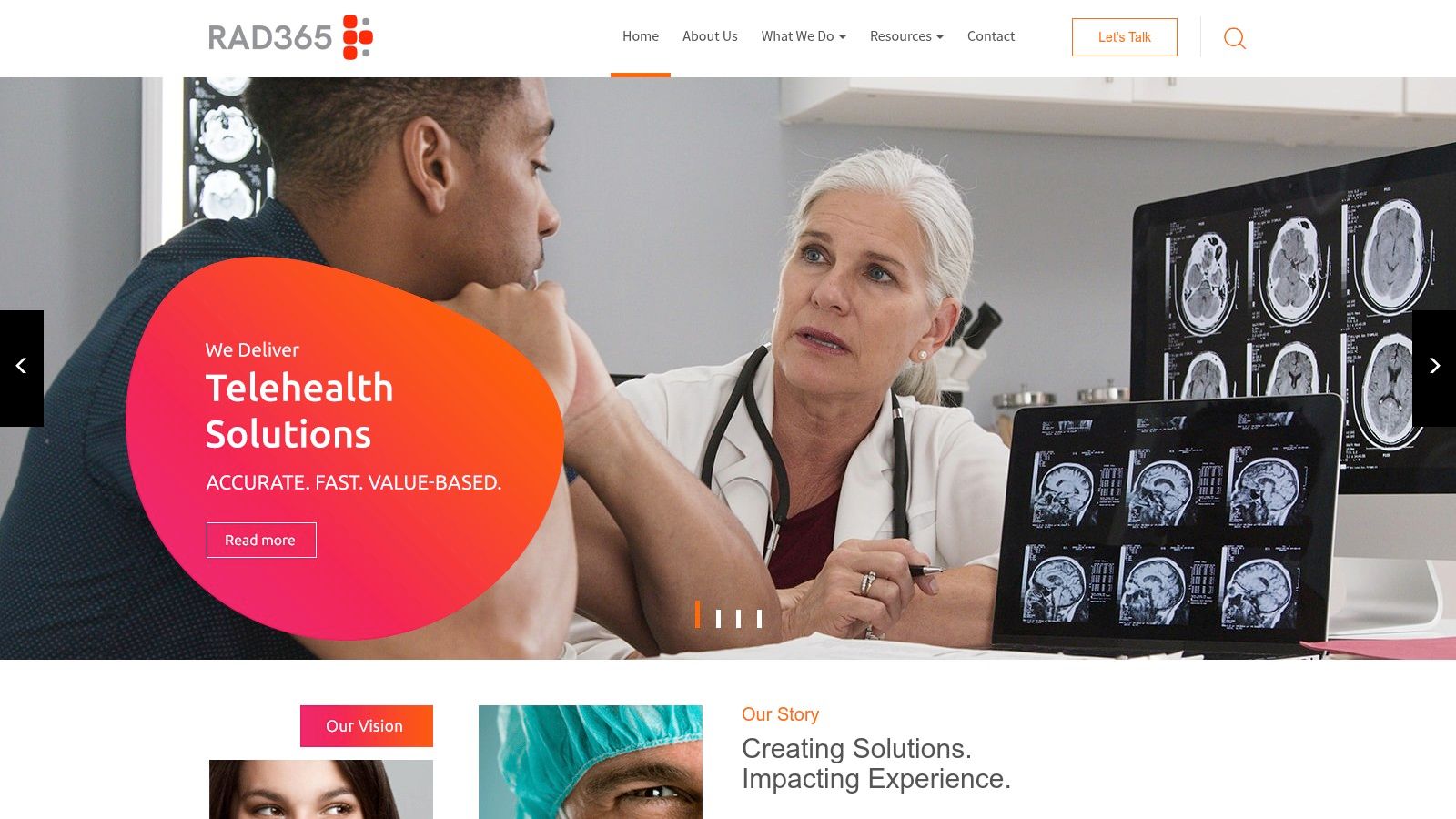
RAD365’s service model is built on speed, precision, and accessibility. The company guarantees impressive turnaround times, delivering routine reports within two hours and critical emergency findings in as little as 15 minutes. This rapid response is crucial for emergency departments and urgent care centers where timely diagnostics directly impact patient outcomes.
Key Features and Strategic Advantages
What truly sets RAD365 apart is its strategic integration of artificial intelligence into its core operations. The company utilizes AI not just as an add-on but as a fundamental component of its workflow, from automated report generation to digital long-term care management. This AI-driven approach significantly enhances diagnostic precision, contributing to its remarkable 99.99% accuracy rate across more than 1.78 million reports. To fully grasp the potential of such an approach, delve into the broader benefits of AI in radiology, which detail how this technology is revolutionizing modern healthcare diagnostics.
The platform's thought leadership in technology is further showcased by its comprehensive offerings, which you can learn more about by exploring their healthcare artificial intelligence solutions. This commitment to innovation ensures that partner facilities are equipped with state-of-the-art tools.
Core Service Highlights:
Rapid Turnaround: Emergency reports are delivered in 15 minutes, with routine cases completed in 2 hours, ensuring no delays in patient care.
Global Expertise: Clients gain access to a network of over 150 global clinical consultants, including a panel of UK- and US-certified radiologists for certified second opinions.
Robust Security: The entire infrastructure is HIPAA-compliant, employing secure networks to guarantee patient privacy and data integrity.
AI-Enhanced Accuracy: Deep learning algorithms support radiologists by improving workflow efficiency and diagnostic confidence, minimizing the potential for human error.
Practical Implementation and Use Cases
For an imaging center or hospital, partnering with RAD365 means seamlessly extending its radiology department's capacity. During overnight shifts or high-volume periods, RAD365 acts as a reliable extension of the in-house team, providing preliminary or final reads without the overhead of hiring additional full-time staff. The availability of certified second opinions also provides an invaluable resource for complex cases, allowing primary care teams to proceed with greater diagnostic certainty.
While RAD365 does not publicly list its pricing, it offers customized quotes based on a facility's specific needs, volume, and required service levels. Prospective clients should anticipate a collaborative onboarding process to integrate RAD365's platform with their existing PACS and EMR systems, ensuring a smooth and secure data flow.
Pros:
Comprehensive 24/7/365 coverage with exceptional turnaround times.
Advanced AI and deep learning integration for superior accuracy.
Strict HIPAA-compliant infrastructure ensuring data security.
Access to second opinions from highly qualified US- and UK-based radiologists.
Extensive global experience with a proven track record.
Cons:
Pricing information is not transparent and requires direct consultation.
Integration with existing healthcare IT systems may require technical customization.
Website: https://www.rad365.com
2. vRad (Virtual Radiologic)
As a dominant force in the U.S. teleradiology market, vRad (Virtual Radiologic) operates as a large-scale, enterprise-level partner for hospitals, health systems, and radiology groups. The platform is engineered for high-volume, continuous coverage, providing 24/7/365 final and preliminary reads backed by a vast network of subspecialists. Its mature, patented technology infrastructure is a key differentiator, handling the entire teleradiology workflow from image routing to report delivery with exceptional reliability.
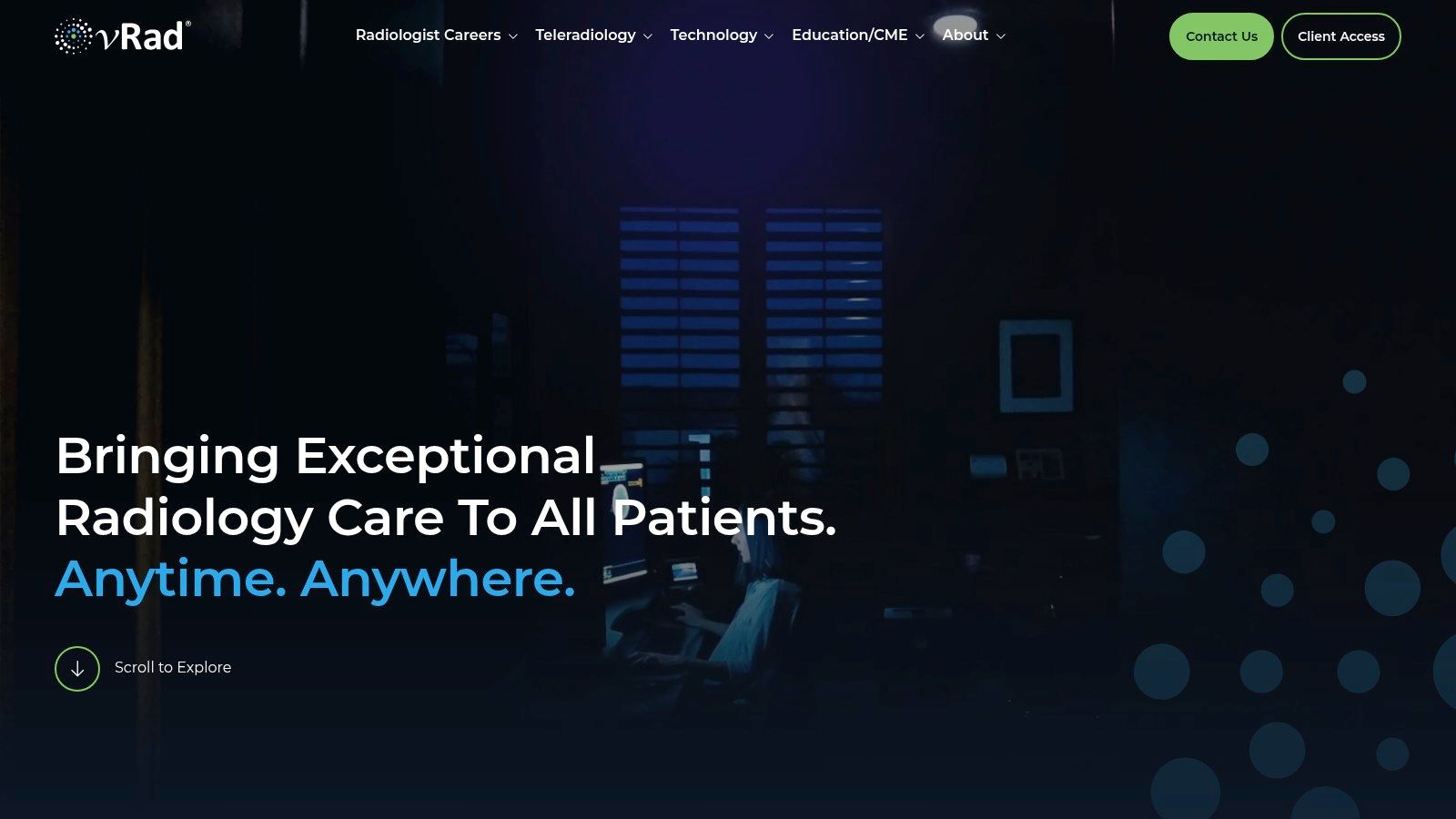
vRad distinguishes itself by integrating sophisticated operational logistics with clinical excellence, positioning it as a thought leader among the top 10 teleradiology companies. The platform offloads non-clinical tasks, allowing providers to focus solely on diagnostics. Furthermore, the integration of over 25 AI models directly into the reading workflow enhances accuracy and efficiency without disrupting the radiologist’s process.
Standout Features and Implementation
vRad’s service model is designed for scalability and flexibility, making it an ideal solution for organizations needing to augment or fully outsource their radiology services.
Virtual FTE Model: A notable offering is the "Virtual FTE" (Full-Time Equivalent) model. This provides a cost-effective, flexible alternative to hiring permanent staff or relying on expensive locum tenens physicians for on-demand or continuous coverage.
Subspecialty Depth: vRad provides extensive subspecialty coverage, including neuroradiology, musculoskeletal, body imaging, and breast imaging, ensuring that complex cases receive expert interpretation at any hour.
Operational Reliability: With a robust, proprietary platform that has processed hundreds of millions of studies, vRad offers high uptime and consistent turnaround times, which are critical for emergency departments and trauma centers.
Pricing and Access
Access to vRad’s services requires a direct partnership. Pricing is customized based on volume, coverage hours, and subspecialty requirements, and is not publicly listed. Interested healthcare organizations must contact vRad for a personalized quote.
Strategic Insight: vRad's strength lies in its industrial-scale operational efficiency and deep bench of subspecialists. It functions less as a service provider and more as a comprehensive radiology practice partner, best suited for organizations that require guaranteed, high-volume coverage where system downtime is not an option.
Pros: Strong operational reliability, large and experienced radiologist network, and comprehensive subspecialty coverage.
Cons: Quote-based pricing can feel opaque, and the service is strictly provider-to-provider with no patient-facing components.
Website: https://www.vrad.com/
3. USARAD
USARAD positions itself as a highly flexible and transparent partner for healthcare facilities across the United States. It provides both final and preliminary teleradiology reports with customizable 24/7/365 coverage, catering to the specific needs of hospitals, imaging centers, and private practices. The company emphasizes a straightforward engagement model, featuring an instant quote system that demystifies the initial cost assessment process, a notable feature in an industry where pricing is often opaque.
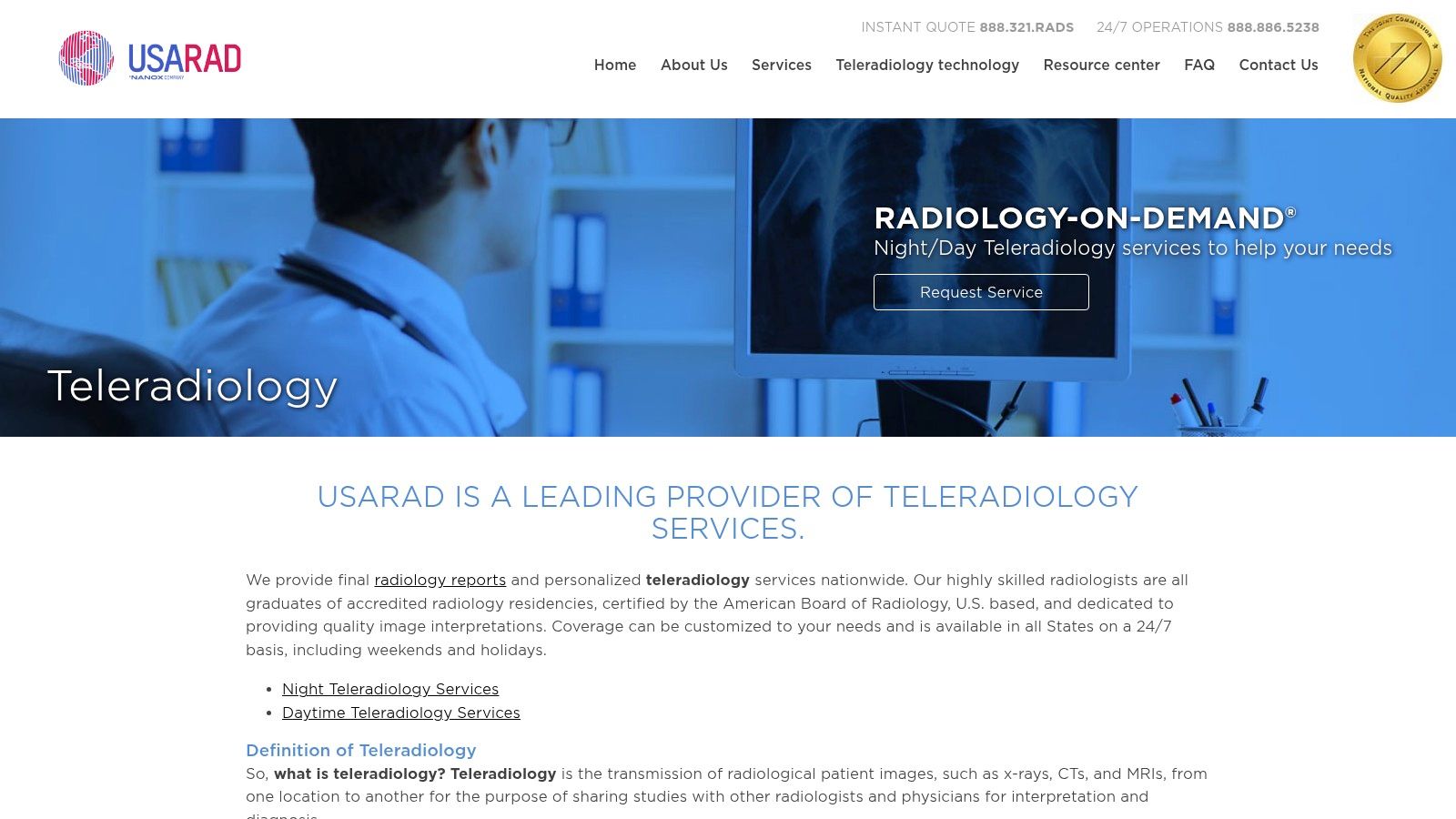
This approach makes USARAD a strong contender among the top 10 teleradiology companies, particularly for organizations seeking predictable costs and adaptable service levels. By maintaining a network of exclusively U.S.-based, ABR-certified radiologists, USARAD ensures high standards of quality and regulatory compliance. The platform's commitment to clear communication and service customization helps build trust and streamline the onboarding process for new partners. This focus on strong healthcare communications fosters better integration with client workflows.
Standout Features and Implementation
USARAD’s model is built on accessibility and customization, allowing clients to tailor coverage precisely to their operational gaps without overcommitting resources.
Instant Quoting System: A key differentiator is the self-service portal on their website, which allows prospective clients to receive an instant, preliminary quote based on modality, volume, and desired turnaround time. This transparency simplifies budget planning.
Flexible Coverage Models: USARAD offers a full spectrum of coverage options, including nighthawk (overnight), daytime, weekend, holiday, and overflow services, enabling facilities to augment their existing staff as needed.
U.S.-Based Radiologists: The company guarantees that 100% of its reading physicians are U.S.-based and Board-Certified, providing peace of mind regarding quality, credentialing, and state licensing.
Pricing and Access
While USARAD does not publish a fixed rate card, its instant quote tool provides a clear starting point for pricing discussions. Final pricing is customized in a formal proposal based on a detailed assessment of the client’s needs, including contract length, study volume, and specific subspecialty requirements. Access is granted upon signing a service agreement.
Strategic Insight: USARAD's primary strength is its fusion of flexibility with pricing transparency. It appeals to facilities that need a reliable, high-quality teleradiology solution but prefer a more straightforward, less enterprise-heavy engagement model than those offered by larger industry players.
Pros: Transparent discussion of costs and quick quoting system, flexible and comprehensive coverage models, and a guarantee of U.S.-based radiologists.
Cons: No public rate card available; exact pricing requires a proposal, and there is limited public data on subspecialty volumes compared to its largest competitors.
Website: https://usarad.com/teleradiology.html
4. ONRAD
ONRAD stands out in the teleradiology landscape as a physician-owned and operated company that champions operational transparency. Accredited by The Joint Commission, it provides customizable preliminary and final read services for hospitals, imaging centers, and radiology groups. ONRAD’s commitment to openly sharing its performance metrics, including turnaround times and quality assurance data, offers a level of accountability that is highly valued by partners seeking clear operational insights.
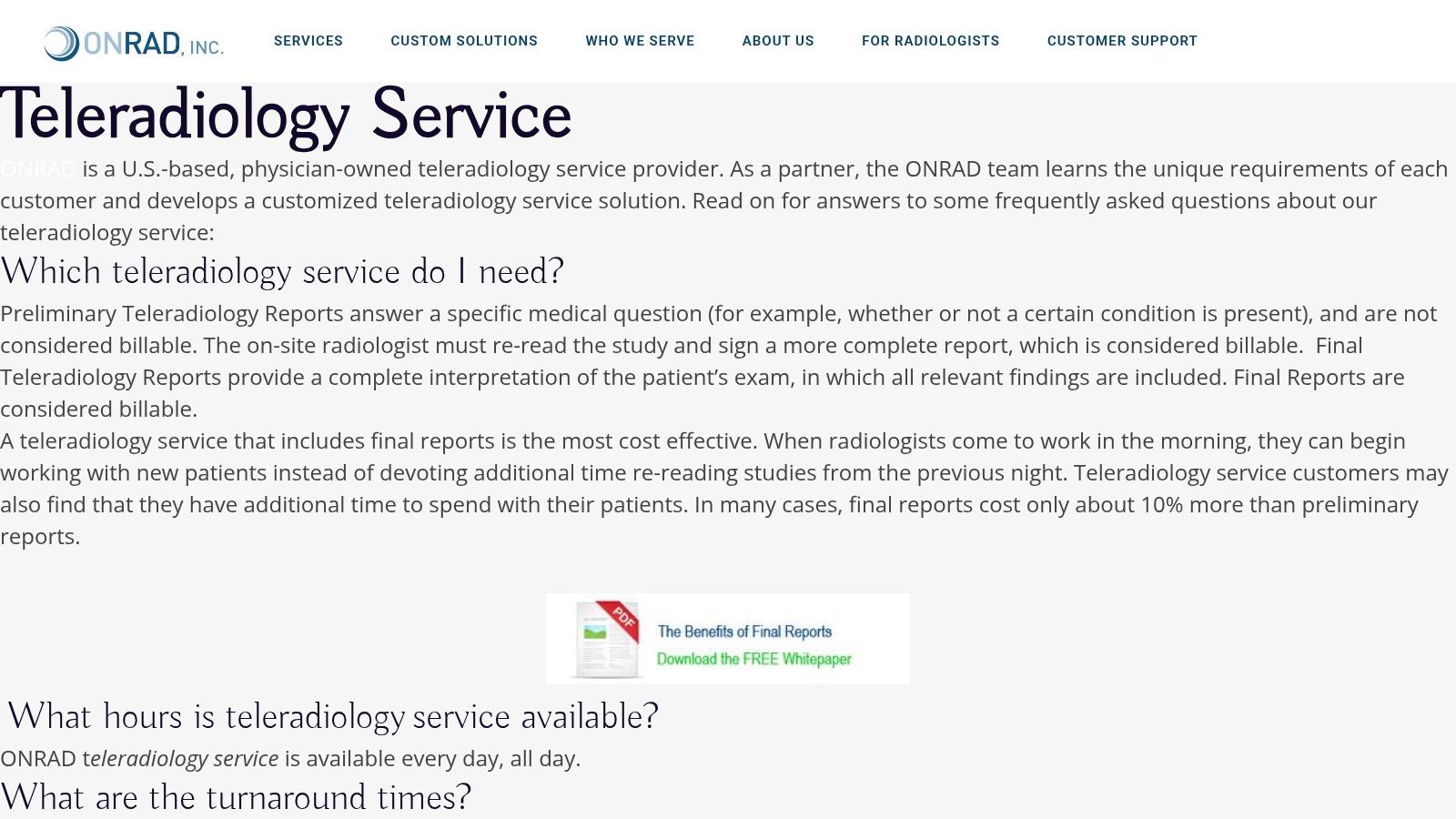
This focus on transparency, combined with a competitive pricing structure, positions ONRAD as a reliable and straightforward partner. The company emphasizes its team of U.S.-based, ABR-certified radiologists, ensuring consistent quality and adherence to high clinical standards. By providing clear explanations of its service levels, such as the small price difference between preliminary and final reads, ONRAD makes it easier for healthcare organizations to choose the right coverage for their needs.
Standout Features and Implementation
ONRAD’s service model is built on flexibility and transparency, offering a clear value proposition for organizations that need dependable teleradiology support without complex fee structures.
Public Performance Metrics: A key differentiator is ONRAD’s public reporting of monthly turnaround time (TAT) and quality assurance (QA) statistics directly on its website, showcasing a commitment to performance and accountability.
Buyer-Friendly Pricing: The company offers competitive pricing with no minimum volume requirements, standby fees, or setup costs. This transparent approach simplifies budgeting and reduces the financial barrier for smaller practices or hospitals.
Comprehensive Coverage: ONRAD provides 24/7/365 coverage with both preliminary and final reads performed by its team of U.S.-based radiologists, ensuring consistent support for routine and emergent cases. It also offers on-site staffing options for a blended solution.
Pricing and Access
ONRAD's services are available through a direct partnership agreement. While specific per-study rates are not published, the company is known for its competitive proposal-based pricing. Interested healthcare facilities must contact ONRAD directly to receive a customized quote based on their specific volume, coverage, and service-level needs.
Strategic Insight: ONRAD's core strength is its commitment to radical transparency, offering publicly available performance data that builds trust and provides measurable quality benchmarks. This makes it an excellent choice for practices and hospitals that prioritize verifiable performance metrics and straightforward, fee-free pricing structures.
Pros: Operational transparency with published performance metrics, a long track record, and a buyer-friendly pricing structure with no hidden fees.
Cons: Pricing is proposal-based with no published rate card, and turnaround time stats shown on the site may be historic; clients should verify current metrics.
Website: https://onradinc.com/teleradiology/
5. Rapid Radiology
Rapid Radiology has carved out a niche as a highly responsive and agile U.S. teleradiology provider, emphasizing speed of deployment and strong customer partnerships. The company offers 24/7/365 coverage with a focus on serving a diverse clientele, including hospitals, radiology groups, mobile imaging providers, and urgent care centers. Its service model is built on flexibility, providing both preliminary and final reads to seamlessly augment existing radiology departments or provide complete outsourced coverage.
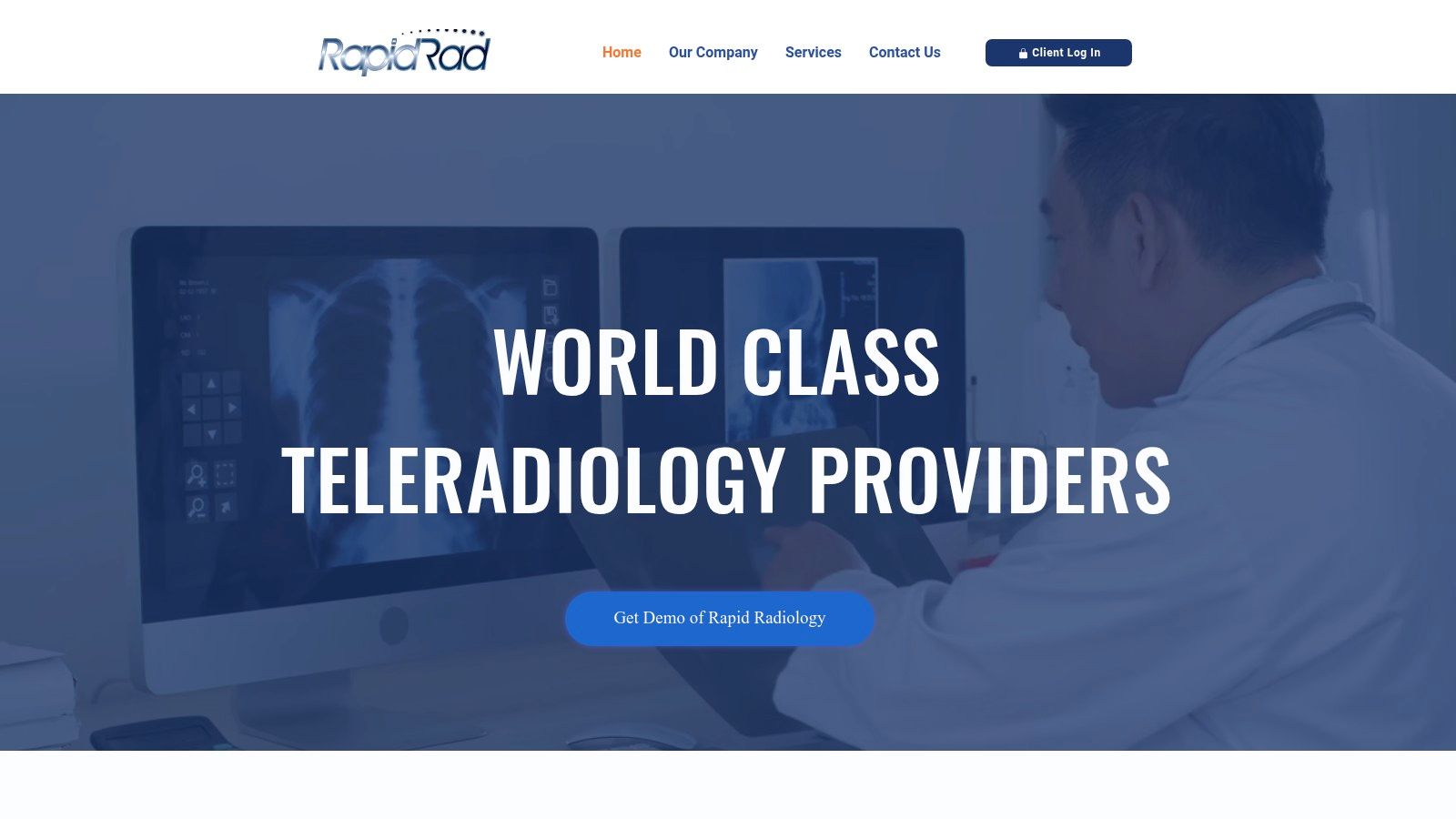
The platform differentiates itself through a high-touch onboarding process and nationwide radiologist licensure, which allows it to service clients across all 50 states without geographic limitations. This comprehensive licensing is a key operational advantage, making Rapid Radiology a go-to choice for multi-state health systems and mobile providers. By positioning itself as a thought leader in service integration, the company ensures its technology and workflows, such as those for time-sensitive stroke protocols, mesh cleanly with a client's existing infrastructure.
Standout Features and Implementation
Rapid Radiology’s implementation is designed to be swift and minimally disruptive, with a dedicated team managing the entire process from initial contact to go-live.
Nationwide Licensure: Radiologists are licensed across the country, providing a single-source solution for organizations with facilities in multiple states and eliminating complex credentialing hurdles.
Rapid Deployment: The company prioritizes a fast and efficient onboarding process, including the installation of a dedicated DICOM gateway to establish a secure, reliable connection for image transfer.
Workflow Integration: Support for critical clinical pathways, including specialized stroke protocols and HL7 integration, ensures that reports are delivered directly into the client’s EMR or RIS, maintaining clinical continuity. Their approach to second opinions showcases this dedication to integrated care, and you can learn more about their case study on second opinions.
Pricing and Access
Rapid Radiology operates on a customized pricing model. Prospective clients must schedule a demo and consultation to receive a quote tailored to their specific needs, including study volume, coverage hours (daytime, nighthawk, or weekend), and required subspecialties. Service menus are clearly defined for different customer types, simplifying the initial engagement process.
Strategic Insight: Rapid Radiology’s core strength is its blend of national reach with personalized, rapid-response customer service. It is an excellent fit for organizations that require a flexible teleradiology partner capable of deploying quickly across multiple states and providing reliable, integrated subspecialty coverage without the bureaucracy of larger providers.
Pros: Nationwide radiologist licensure, strong emphasis on customer support and fast onboarding, and clear service models tailored to different client types.
Cons: Pricing is not public and requires a consultation, and there is limited publicly available data on performance metrics like turnaround times.
Website: https://www.rapidradiology.com/
6. National Diagnostic Imaging (NDI)
National Diagnostic Imaging (NDI) carves out a unique niche in the teleradiology landscape by prioritizing pricing transparency. This U.S.-based teleradiology group provides final interpretations and subspecialty reads, but its primary differentiator is its publicly available per-study price list. This approach directly addresses a common pain point for small to medium-sized imaging centers, clinics, and hospitals that need clear, upfront cost information for budgeting and comparison.
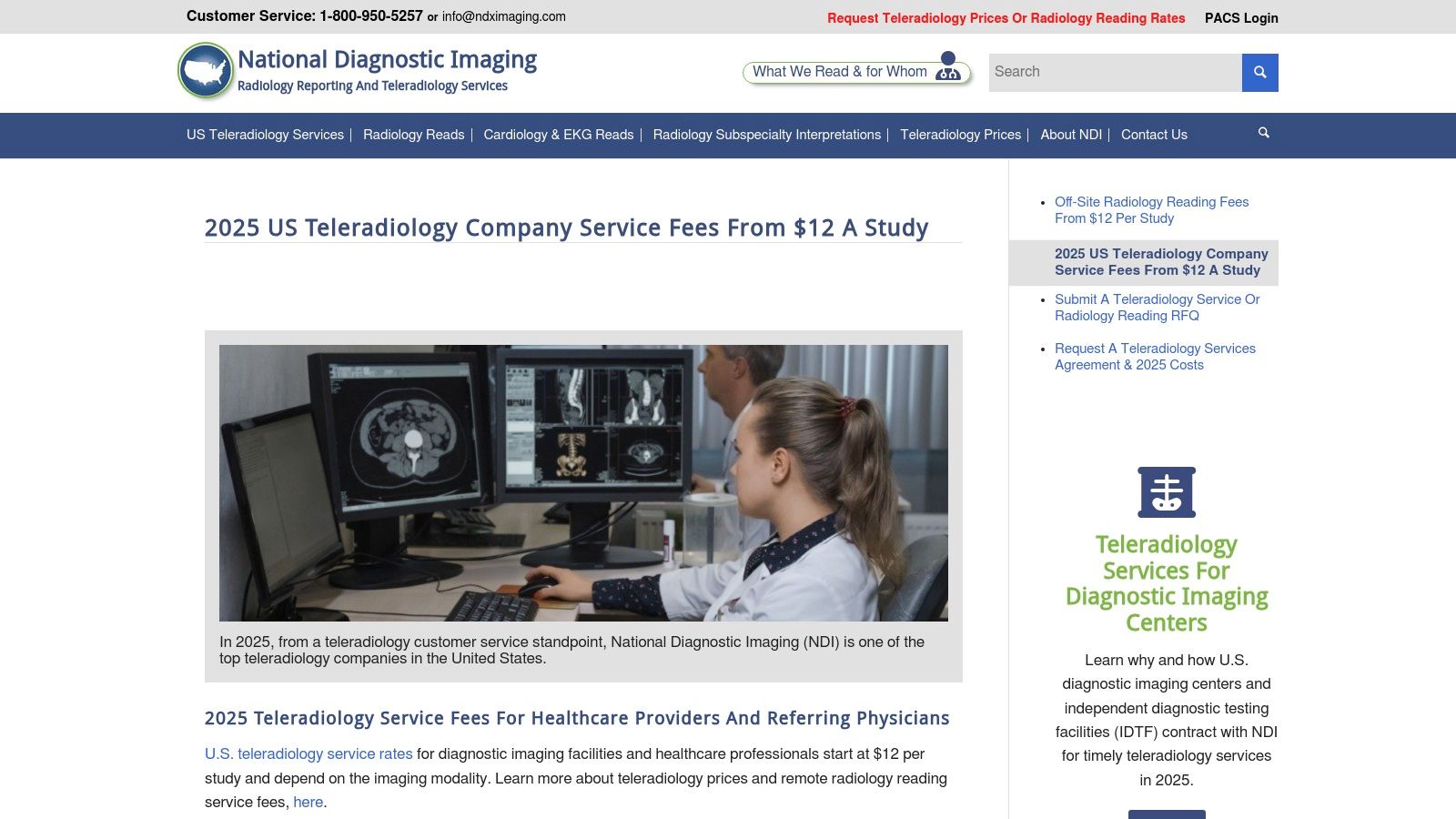
By publishing its pricing model, NDI demystifies the cost structure often hidden behind custom quotes, positioning itself as a straightforward partner for providers seeking predictable expenses. While serving a nationwide client base, its model is particularly well-suited for organizations that may not have the high case volumes required by larger enterprise providers, making it a valuable entry in the list of top 10 teleradiology companies.
Standout Features and Implementation
NDI’s service is built around accessibility and clarity, allowing healthcare facilities to easily forecast and manage their radiology reading costs without lengthy negotiations.
Public Price List: NDI’s most distinctive feature is its published price list, which details example per-study costs for modalities like X-ray, Ultrasound, CT, MRI, and PET/CT. This allows potential clients to estimate expenses immediately.
Comprehensive Modality Coverage: The service covers a wide array of imaging studies, including general radiography, mammography, nuclear medicine, and advanced imaging, with subspecialty interpretations available to ensure expert reads.
PACS and Setup Support: For facilities that need technical assistance, NDI offers support for PACS (Picture Archiving and Communication System) setup, helping to streamline the integration process for a smooth workflow.
Pricing and Access
NDI’s transparent pricing is its core value proposition. While the company publishes a detailed price list on its website with baseline rates for 2025, these are starting points. Final costs are provided through a custom quote that considers specific factors like case volume, required turnaround times, and the modality mix. Access is provider-to-provider, requiring direct contact to establish a service agreement.
Strategic Insight: NDI's strength lies in its radical transparency within an industry known for opaque pricing. This makes it an ideal starting point for smaller practices, urgent care centers, and imaging facilities that need to conduct cost-benefit analyses with clear, predictable data before committing to a long-term partnership.
Pros: Transparent, publicly available pricing simplifies budgeting; a strong option for cost comparison; and nationwide coverage for multiple modalities.
Cons: Published rates are "from" prices and can vary; has less brand recognition and scale compared to dominant market leaders.
Website: https://www.ndximaging.com/prices/general-teleradiology-prices-2/
7. Teleradiology Solutions (TRS)
Teleradiology Solutions (TRS) is a pioneering global teleradiology group with a significant U.S. presence, serving over 150 hospitals across multiple continents. Founded by Yale-trained physicians, the company leverages its international footprint to provide 24/7/365 subspecialty reporting, making it an excellent choice for health systems that require resilient, round-the-clock coverage with built-in redundancy. TRS operates multiple reporting centers worldwide, ensuring continuous service and rapid turnaround times irrespective of time zones.
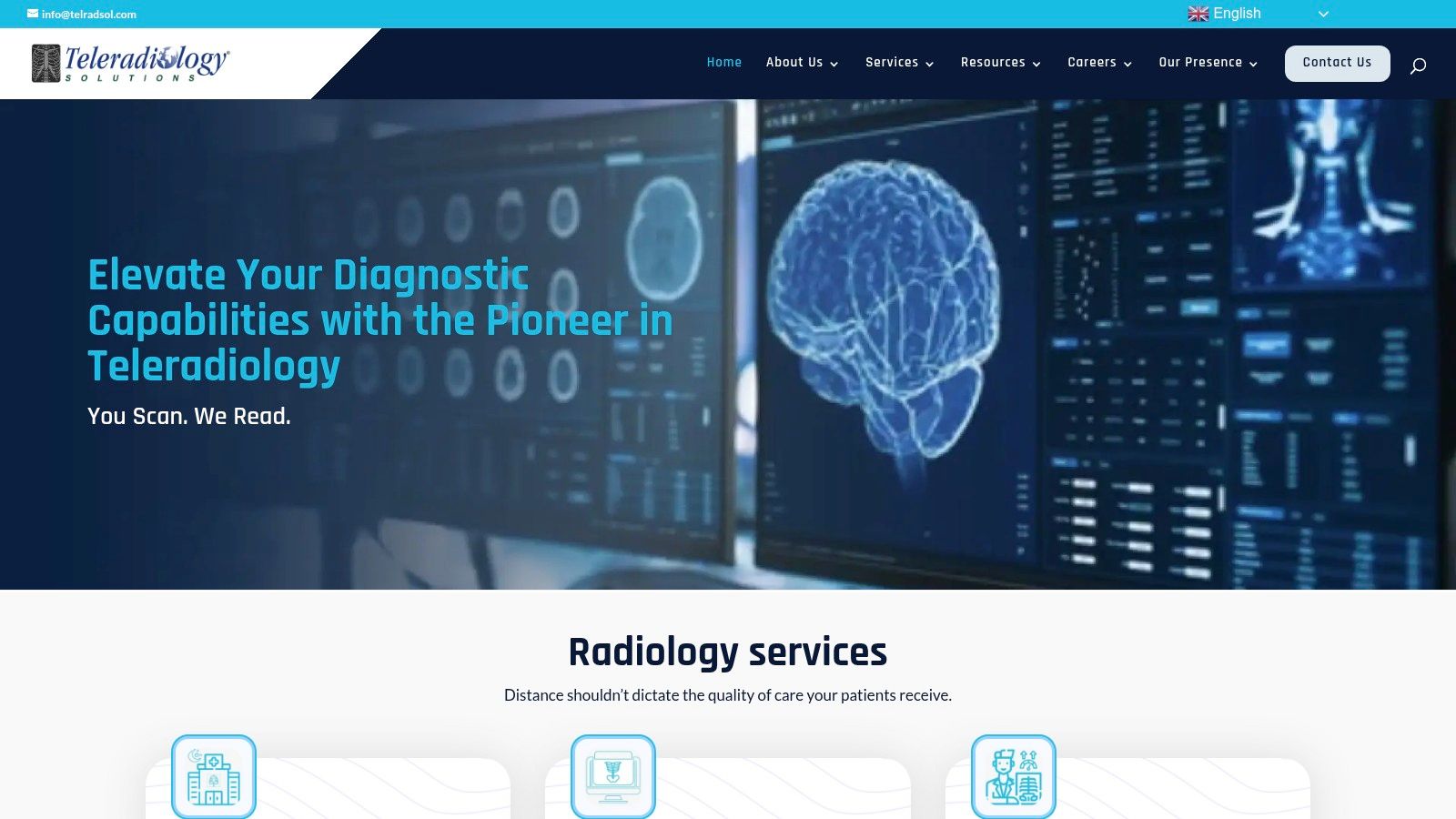
As one of the top 10 teleradiology companies, TRS distinguishes itself with a strong emphasis on clinical quality and thought leadership, backed by its Joint Commission accreditation. The company’s technology arm developed RADSpa, a proprietary workflow optimization platform that enhances reporting efficiency and integration. This combination of global operational scale and in-house technological innovation positions TRS as a reliable partner for organizations needing broad modality support and international expertise.
Standout Features and Implementation
TRS is designed for health systems that prioritize global scale, comprehensive modality coverage, and operational resilience. Its model is particularly suited for organizations with international operations or those needing guaranteed after-hours coverage.
Global, Redundant Coverage: With reporting centers in the USA, UK, India, and UAE, TRS offers a "follow-the-sun" model. This ensures that studies are always read by an alert, on-duty radiologist, providing true 24/7 coverage and operational continuity.
Broad Modality Support: The service covers a wide spectrum of imaging modalities, including CT, MRI, X-ray, ultrasound, nuclear medicine, and even subspecialties like echocardiography, catering to diverse diagnostic needs.
Integrated Technology Platform: Its proprietary RADSpa platform is an intelligent workflow engine that streamlines the entire teleradiology process, from study routing and assignment to report delivery, optimizing efficiency for both the client and the radiologist.
Pricing and Access
TRS operates on a partnership model with customized pricing. Access to its services is proposal-based, and interested healthcare facilities must contact the company directly for a quote tailored to their specific volume, modality mix, and service-level requirements.
Strategic Insight: TRS's core strength is its globally distributed, multi-center infrastructure, which provides unmatched operational redundancy and 24/7 subspecialty access. It is an ideal partner for large health systems or multinational healthcare groups that require a scalable, resilient, and technologically advanced teleradiology solution.
Pros: Deep international experience and broad modality support, ideal for organizations with global operations needing round-the-clock reads.
Cons: Pricing is not publicly available and proposal-based only; some reads may originate outside the U.S., requiring client verification on licensing and credentialing.
Website: https://telradsol.com/
Top 7 Teleradiology Companies Comparison
Provider | Implementation Complexity | Resource Requirements | Expected Outcomes | Ideal Use Cases | Key Advantages |
|---|---|---|---|---|---|
RAD365 | Moderate - may need customization | Robust team, AI tech, global network | Rapid, accurate reports with 99.99% accuracy | Healthcare providers needing 24/7 AI-driven teleradiology | Advanced AI integration, 24/7 global coverage, strict privacy compliance |
vRad (Virtual Radiologic) | Moderate - mature, scalable platform | Large subspecialist network, patented tech | Reliable, subspecialty reads 24/7 | Hospitals/groups needing large-scale teleradiology | Extensive subspecialty coverage, patented tech, Virtual FTE option |
USARAD | Low - self-service portal available | U.S.-based ABR-certified radiologists | Flexible, transparent pricing with 24/7 coverage | Facilities wanting transparent pricing and flexible options | Transparent quotes, flexible coverage, U.S.-based radiologists |
ONRAD | Low to Moderate - transparent setup | ABR-certified U.S. radiologists | Competitive pricing with published TAT/QA data | Providers valuing operational transparency and buyer-friendly terms | Public performance metrics, no fees or minimums |
Rapid Radiology | Moderate - onboarding and integration | Nationwide licensing, HL7 support | Fast deployment with comprehensive subspecialty support | Hospitals/groups needing quick startup & nationwide licensing | Strong customer support, stroke protocol support |
National Diagnostic Imaging (NDI) | Low - straightforward adoption | Smaller scale, pricing transparency | Budget-friendly with clear pricing per modality | Small to mid-sized sites needing clear budget planning | Public per-study pricing, subspecialty reads |
Teleradiology Solutions (TRS) | Moderate to High - multi-region setup | Multi-region reporting centers, tech platform | 24/7 subspecialty reporting with global redundancy | Health systems requiring international scale and coverage | Global network, Joint Commission accredited, broad modality support |
Making Your Strategic Choice: Final Thoughts on Selecting the Right Teleradiology Partner
Navigating the landscape of the top 10 teleradiology companies reveals a clear truth: the ideal partner is not a one-size-fits-all solution. Your final decision extends beyond filling a gap in your radiologist schedule. It is a strategic alliance that directly impacts your facility's clinical excellence, operational efficiency, and ultimately, the quality of patient outcomes.
Throughout this guide, we've explored providers with distinct strengths. We've seen how large-scale networks like vRad offer unparalleled subspecialty depth, while players like USARAD provide flexible, on-demand solutions. The choice hinges on a deep understanding of your organization's specific needs, challenges, and long-term strategic goals. A partner that perfectly serves a high-volume urban hospital may not be the optimal fit for a rural imaging center needing after-hours nighthawk support.
From Comparison to Conversation: Actionable Next Steps
To move forward, transform this information into a structured evaluation framework. The key is to shift from passively comparing features to actively engaging with potential partners. Use the insights from this article to initiate meaningful conversations that uncover the true value and cultural fit of each provider.
Here are the critical factors to guide your selection process:
Define Your Non-Negotiables: Before you request a single demo, create a scorecard of your must-have requirements. Is it 24/7/365 neuroradiology coverage? Is it a guaranteed 30-minute turnaround time for STAT ER studies? Or is it seamless integration with your specific RIS/PACS system? Clarity on these points will quickly narrow your options.
Scrutinize the Technology Stack: A teleradiology company's platform is your window into their operations. During a demo, look beyond the user interface. Ask specific questions about their approach to data security, HIPAA compliance, and system uptime. Inquire about their roadmap for incorporating AI tools for triage or quality assurance, as this indicates a forward-thinking, innovative partner.
Evaluate the Quality Assurance (QA) Engine: How does the company ensure diagnostic accuracy and consistency? Request details on their peer-review process, quality scoring metrics, and protocols for handling discrepancies. A transparent, rigorous QA program is the bedrock of a trustworthy partnership.
Request a Pilot Program: The most effective way to assess a provider's performance is to test their service in a controlled environment. Propose a limited-scope pilot or trial period to evaluate their workflow, communication, and the quality of their reports firsthand. This practical test run provides invaluable data for making a confident, long-term decision.
The right teleradiology partner will function as an extension of your own team. They will not only deliver accurate and timely reads but will also provide insights that help you optimize your entire diagnostic imaging service line. This decision is an investment in your facility's future, enabling you to expand your capabilities, enhance patient care, and thrive in an ever-evolving healthcare environment.
As you evaluate the top 10 teleradiology companies, consider how a partner committed to next-generation technology can elevate your practice. RAD365 is at the forefront of this evolution, integrating advanced AI and a global network to deliver unparalleled speed, accuracy, and clinical intelligence. Discover how our platform can become your strategic advantage by visiting RAD365 to request a personalized demo.
